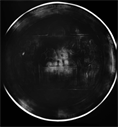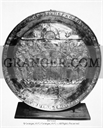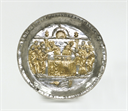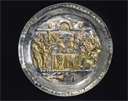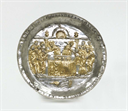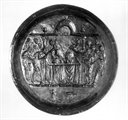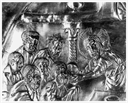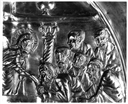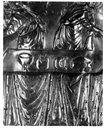Bibliography
O. K. Wulff, Die altchristliche und byzantinische Kunst Handbuch der Kunstwissenschaft (Berlin-Neubabelsberg, 1913), 199.
L. Bréhier. "Les trésors d'argenterie syrienne et l'école artistique d'Antioche," Gazette des Beaux Arts 62 (1920), 176.
———, The Treasures of Syrian Silverware and the Art School of Antioch (Paris, 1921). "Les trésors d'argenterie syrienne et l'école artistique d'Antioche," Gazette des Beaux Arts 62 (1920), fig. opp. p. 6.
C. Diehl. "L'école artistique d'Antioche et les trésors d'argenterie syrienne," Syria 2 (1921), 81-95, esp. 81, fig. 14.
W. F. Volbach. "Der Silberschatz von Antiochia," Zeitschrift für bildende Kunst 54 (1921), esp. 110.
M. Rosenberg, Der goldschmiede Merkzeichen (Frankfurt am Main, 1922-28), 4, 686-687, pl. 9870-9879.
L. Bréhier, L'art byzantin Les patries de l'art (Paris, 1924), pl. 61.
O. M. Dalton, East Christian Art, A Survey of the Monuments (Oxford, 1925), 330.
C. Diehl, Manuel d'art byzantin (Paris, 1925), 316.
W. Neuss, Die Kunst der alten Christen Von heileger Kunst, Veröffentlichungen des Verbandes der Vereine Katholischer Akademiker zur Pflege der katholischen Weltanschauung (Augsburg, 1926), pl. 138.
H. Peirce, and R. Tyler, Byzantine Art Kai Khosru Monographs on Eastern Art (London, 1926), 26, fig. 19.
L. Matzulevich, Byzantinische Antike. Studien auf Grund der Silbergefässe der Ermitage Archäologische Mitteilungen aus russischen Sammlungen (Berlin and Leipzig, 1929), 63.
W. F. Volbach. "Die byzantinische Ausstellung in Paris," Zeitschrift für bildende Kunst 63 (1930-31), 108.
Exposition internationale d'art Byzantin, exhibition catalogue, Musée des Arts Décoratifs, Palais du Louvre, 28 May-9 July, 1931, (Paris, 1931), 130, no. 410.
J. Braun, Das christliche Altargerät in seinem Sein und in seiner Entwicklung (München, 1932), 202 n. 1, 210, pl. 146.
H. Peirce, and R. Tyler, L'Art Byzantin (Paris, 1932-34), 115, fig. 144.
W. F. Volbach, G. Duthuit, and G. Salles, Art byzantin (Paris, 1933), 62-63, fig. 56.
D. Talbot Rice, Byzantine Art (Oxford, 1935), 162-163, fig. 35a.
L. Bréhier, La sculpture et les arts mineurs byzantins (Paris, 1936), 85-86, fig. 14.
The Dark Ages; Loan Exhibition of Pagan and Christian Art in the Latin West and Byzantine East, exhibition catalogue, Worcester Art Museum, February 20-March 21, 1937, (Worcester, Mass., 1937), 41, no. 115, pl. 115.
C. R. Morey. "Art of the Dark Ages: A Unique Show. The First American Early Christian-Byzantine Exhibition at Worcester," Art News 35, no. 21 (1937), 9-16, 24., esp. 13.
L. Jalabert, and R. Mouterde, Inscriptions grecques et latines de la Syrie,Chalcidique et Antiochène Bibliothèque archéologique et historique (Paris, 1939), no. 695.
The Dumbarton Oaks Research Library and Collection of Harvard University,Handbook of the Collection (Washington, D.C., 1946), 53, no. 102, pl. p. 56.
"Reawakening at Dumbarton Oaks: The Golden Glories of the Byzantine and Early Christian Worlds," Art News 45, no. 10.1 (1946), 15-19; 57-59, esp. 57, pl. VII.
K. Weitzmann. "Byzantine Art and Scholarship in America," American Journal of Archaeology 51 (1947), 394-418, esp. 398, fig. CIV.
S. G. Xydis. "The Chancel Barrier, Solea, and Ambo of Hagia Sophia," Art Bulletin 29 (1947), 1-24, esp. 10.
The Dumbarton Oaks Collection, Harvard University (Washington, D.C., 1955), 55, no. 129, pl. p. 68.
C. Diehl, Byzantium: Greatness and Decline Rutgers Byzantine series (New Brunswick, N.J., 1957), pl. p. 106.
E. C. Dodd, Byzantine Silver Stamps Dumbarton Oaks Studies (Washington, D.C., 1961), no. 20.
O. Nussbaum. "Zum Problem der runden und sigmaförmigen Altarplatten," Jahrbuch für Antike und Christentum 4 (1961), 18-43, esp. 18, pl. 1.
M. C. Ross, Metalwork, Ceramics, Glass, Glyptics, Painting Catalogue of the Byzantine and Early Mediaeval Antiquities in the Dumbarton Oaks Collection (Washington, D.C., 1962), 12-15, no. 10, fig. 11-13.
V. H. Elbern. "Der eucharistische Kelch im frühen Mittelalter," Zeitschrift für Kunstwissenschaft 17 (1963), 1-76, 117-88, esp. 171, pl. 116.
Byzantine Art, an European Art, exhibition catalogue, Zappeion Exhibition Hall, (Athens, 1964), no. 484.
V. H. Elbern, Der eucharistische Kelch im frühen Mittelalter (Berlin, 1964), 134, pl. 116.
K. Wessel, Abendmahl und Apostelkommunion Ikonographia Ecclesiae Orientalis (Recklinghausen, 1964), 9-18.
Handbook of the Byzantine Collection (Washington, D.C., 1967), 17, no. 61.
C. Schug-Wille, Byzanz und seine Welt Kunst im Bild (Baden-Baden, 1969), pl. p. 131.
P. R. L. Brown, The World of Late Antiquity, AD 150-750 (New York, 1971, reprinted 2014), pl. between p. 134-135.
J. L. Schrader. "Antique and Early Christian Sources for the Riha and Stuma Patens," Gesta 18, no. 1 (1979), 147-56.
K. Weitzmann, Age of Spirituality : Late Antique and Early Christian Art, Third to Seventh Century, exhibition catalogue, Metropolitan Museum of Art, November 19, 1977-February 12, 1978, (New York, 1979), 611-612, no. 547, colorpl. 16.
C. Mango. "The Byzantine Collection," Apollo 119 (1984), 21-29, pl. 2.
R. Cormack, Writing in Gold: Byzantine Society and its Icons (London, 1985), 31, pl. 7.
M. M. Mango, C. E. Snow, and T. Drayman Weisser, Silver from Early Byzantium: the Kaper Koraon and Related Treasures, exhibition catalogue, Walters Art Gallery, 18-August 17, 1986, (Baltimore, Md., 1986), no. 35.
J. M. C. Toynbee, and K. S. Painter. "Silver Picture Plates of Late Antiquity: A.D. 300 to 700," Archaeologia 108 (1986), 15-65, no. 80.
R. Warland. "Das Brustbild Christi," Römische Quartalschrift für christliche Altertumskunde und Kirchengeschichte 41 (1986), 74, pl. 70.
R. L. P. Milburn, Early Christian Art and Architecture (Berkeley, 1988), 262, pl. 170.
L. Rodley, Byzantine Art and Architecture: An Introduction (Cambridge [England] ;New York, N.Y., 1994), 98, pl. 72.
J.-P. Caillet, L'art du Moyen Age : Occident, Byzance, Islam Collection Manuels d'histoire de l'art (Paris, 1995), 43, pl. 35.
J. Lowden, Early Christian & Byzantine Art Art & ideas (London, 1997), 80, pl. 42.
M. B. McNamee, Vested Angels : Eucharistic Allusions in Early Netherlandish Paintings Liturgia Condenda (Leuven, 1998).
M. Collins, and M. A. Price, The Story of Christianity: 2,000 Years of Faith (New York, 1999), 102.
J. Durand, L'art byzantin (Paris, 1999), 53, pl. p. 47.
A. D. Lee, Pagans and Christians in Late Antiquity: A Sourcebook (London and New York, 2000), 242, fig. 13.7.
C. L. Connor, Women of Byzantium (New Haven, 2004), 99, pl. 14.
A. Kirin, J. N. Carder, and R. S. Nelson, Sacred Art, Secular Context : Objects of Art from the Byzantine Collection of Dumbarton Oaks, Washington, D.C., Accompanied by American Paintings from the Collection of Mildred and Robert Woods Bliss, exhibition catalogue, Georgia Museum of Art, (Athens, Ga., 2005), 44, pl. 6.
R. S. Nelson, K. M. Collins, and C. Barber, Holy Image, Hallowed Ground : Icons from Sinai, exhibition catalogue, J. Paul Getty Museum, November 14, 2006-March 4, 2007, (Los Angeles, 2006), 216-217, no. 37.
G. Bühl, ed. Dumbarton Oaks: The Collections. Washington, D.C.: Dumbarton Oaks Research Library, 2008, 76-79.
R. Cormack, M. Vasilaki, and B. Mouseio, Byzantium, 330-1453, exhibition catalogue, Royal Academy of Arts, London, October 25, 2008 - March 22, 2009, (London and New York, 2008), 78-79, 383, no. 20.
A. Doig, Liturgy and Architecture from the Early Church to the Middle Ages Liturgy, Worship, and Society (Aldershot, England and Burlington, Vt., 2008), 65, fig. 2.
W. R. Levin. "The Canopy of Holiness at the Misericordia in Florence and Its Sources (Part Two)," Southeastern College Art Conference Review 15, no. 4 (2009), 393-407.
R. Toman, R. Warland, and A. Bednorz, Ars Sacra: Christian Art and Architecture of the Western World from the Very Beginning up until Today (Köln: Basingstoke, 2010), 78.
A. D. Lazaridou, A. Cameron, H. Saradi-Mendelovici, H. Maguire, and S. ?ur?i?, Transition to Christianity: Art of Late Antiquity, 3rd-7th Century AD, exhibition catalogue, Mouseio Vyzantino, Athens, December 7th, 2011- May 14th 2012, (New York and Athens, 2011), 142, no. 106.
N. Thomas, "Recognizing Niello: Three Aegean Daggers," in Exotica in the Prehistoric Medierranean, ed. A. Vianello (Oxford; Oakville, CT, 2011), 146-61, esp. 148, 156, fig., 23.
C. Lakey. "The Curious Case of the Chiarito Tabernacle: A New Interpretation," Getty Research Journal, no. 4 (2012), 13-30, esp. 17, pl. 3.
W. D. Ray, Tasting Heaven on Earth: Worship in Sixth-Century Constantinople The Church at Worship: Case Studies from Christian History (Grand Rapids, Mich., 2012), 29.
T. Frese, Aktual- und Realpräsenz: Das eucharistische Christusbild von der Spätantike bis ins Mittelalter Neue Frankfurter Forschungen zur Kunst (Berlin, 2013), 63, fig. 3.
H. Hunter-Crawley, "Embodying the Divine: The Sensational Experience of the Sixth-Century Eucharist," in Making Senses of the Past: Toward a Sensory Archaeology, ed. J. Day. Center for Archaeological Investigations Occasional Paper (Carbondale, IL, 2013), esp. 165, pl. 8-1.
J. Moorhead, The Roman Empire Divided, 400-700 (Harlow, England; New York, 2013), 209, fig. 13.
D. Krueger, Liturgical Subjects: Christian Ritual, Biblical Narrative, and the Formation of the Self in Byzantium, 2014), 113, pl. 13.
A. Effenberger and N. Asutay-Effenberger, Byzanz: Weltreich der Kunst (Munich: Beck, 2017), 110, fig. 38.
Bulletin of the Fogg Art Museum 10, no. 4 (Dec. 1945), 108, pl. p. 115.
"Stately Outpost," Harvard Magazine (March 1998).
"Icons of the East," The Voice of the Students and Alumni of St. Mary's of Baltimore 20, no. 6 (March, 1943), 9, 28, esp. 9, 28.
B. Fourlas, "Image and Chalcedonian Eucharistic doctrine: a re-evaluation of the Riha paten, its decoration and its historical context," in Byzantinische Zeitschrift vol. 114, no. 3 (2021): 1117-1160.

